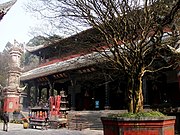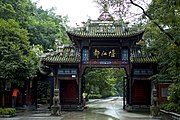Dujiangyans bevattningssystem
Från Rilpedia
| Qingchengshan och Dujiangyans bevattningssystema Världsarv nr 1001 |
|
 |
|
| Land | |
| Geografiskt läge | Koordinater: |
| Typ | Kulturarv |
| Kriterium | ii, iv, vi |
| Regionb | Asien och Oceanien |
|
Inskriptionshistorik |
|
| Inskrivet | 2000 Världsarvskommitténs 24:e möte |
|
a Officiellt namn översatt till svenska |
|
Dujiangyan (förenklad kinesiska: 都江堰|t=都江堰 pinyin: Dūjiāngyàn) är en infrastruktur för bevattning byggt 256 f.Kr under De krigande staternas period av staten Qin. Det ligger vid Minjiang i Sichuanprovinsen i Kina. Bevattningssystemet är ännu i bruk och ger över 5 300 km² land vatten[1]
Innehåll |
Historia
Planering
Under de krigande staternas period för omkring 2 300 år sedan, var folket vid Minjiangs flodbanker utsatta för årliga översvämningar. Qins guvernör Li Bing utredde problemet och upptäckte att floden växte på grund av det snabba smältvattnet från de närliggande bergen som slår emot bankarna när det nådde det långsamma och starkt siltade sträckan nedanför[2].
Den mest uppenbara lösningen skulle ha varit att byggt en damm, men Li Bing hade även fått i uppdrag att hålla vattenvägen öppen för militär sjöfart för att förse trupper vid fronten,[3], istället föreslog han att bygga en konstgjord vall för att omdirigera en del av flodens vattenflöde och sedan skapa en kanal genom Yuleishan för att leda bort överflödigt vatten till den torra Chengduplatån.[4]
Construction
Li Bing fick 100 000 taeler silver för projektet från kung Zhao av Qin och påbörjade arbetet med ett team som sägs ha varit tiotusentals. Vallen uppfördes från långa korvformade korgar av vävd bambu fyllda med sten känd som Zhulong[5] håls på plats av trebenta träbitar kända som Macha.[6] The massive construction took four years to complete.[7]
Att gräva kanalen visade sig vara ett långt större problem då de verktyg som var tillgängliga vid denna tid, före uppfinnandet av krutet, inte kunde penetrera det hårda berget, så han använde en kombination av eld och vatten för att hetta upp och kyla berget till dess det sprack och kunde tas bort[8]. Efter åtta års arbete hade en 20 meter lång kanal genom berget blivit klar.[9]
Legacy
Efter att systemet stod klart var det slut på översvämningar. Bevattningssystemet gjorde Sichuan till det mest produktiva jordbruksområdet i Kina. Li Bing älskades så mycket att han blev en gud för folket där. På östra sidan av Dujiangyan, uppförde folket en helgedom till minne av Li Bing.
Li Bings konstruktion sägs också ha gett folket i regionen en avslappnad livssyn,[10] by eliminating disaster and insuring a regular and bountiful harvest it has left them with plenty of free-time.[11]
Idag är Dujiangyans bevattningssystem en stor turistattraktion och år 2000 blev det ett världsarv
Tempel
Två kungars tempel
Erwang eller Två kungars tempel ligger vid foten av Yuleishan alldeles intill floden. Det ursprungliga Wangditemplet byggt till minne av en forntida Shukung flyttades och lokalbefolkningen bytte namn på templet för att ära Li Bing och hans legendariska son vilka dom postumt upphöjt till kungar[12]
Det 10 072 m² träkomplexet från Qingdynastins tid, har det traditionella utseendet av ett tempel förutom att den inte följer en nord-sydlig axel[13]. Huvudhallen, som har en modern staty av Li Bing[14], opens up onto a courtyard facing an opera stage. On Li Bing's traditional birthday, 24th day of the 7th month of the lunar calendar,[15] local operas were performed for the public,[16].
Den bakre salen har en modern staty av guden Erlang Shen som was allegedly Li Bing’s son,[17] men historiska källor misslyckas bekräta detta och det är möjligt att han uppfanns av lokalbefolkningen för att ge deras hjälte en ättling för att underhålla hans familjearv.[18] Guanlantinpaviljongen ligger ovanför komplexet och har visdomsord från Li Bing inskrivna såsom: När floden går fram i sick-sack, skär en rak kanal, när flodbädden är bred och grund, gräv den djupare.[19].
Draktämjartemplet
Fulonguan eller Draktämjartemplet i Liudiparken grundades under 200-talet till Fan Changshengs ära, den som grundade daoismen. Efter Li Bengs död byggdes en hall här i hans ära och templet bytte namn för att minna om legenderna om drakkamperna som omgav honom.[20]
Det är här som Erlang Shen, den Li Bings legendariska son, sägs ha kedjat draken som han och hans 7 vänner fångade in i ett bakhåll vid River God Temple när den kom för att ta ett mänskligt offer. Denna handling sägs ha skyddat regionen från översvämningar allt sedan dess[21].
Under den Handynastin sattes en staty av Li Bing i floden att kunna övervaka vattenflödet. Om vattennivån nådde hans skuldror indikirade detta högvatten och föll den nedanför hans vader var det torka. Statyn, som är den äldsta kända stenstatyn i Kina som avbildar en människa, flyttades från sin plats och till huvudsalen[22][23].
Referenser
- Denna artikel är helt eller delvis baserad på material från engelskspråkiga Wikipedia
- ↑ World Heritage in China. ISBN 7-5623-2390-9.
- ↑ ”Dujiangyan Irrigation System”. travelchinatour.com. http://www.travelchinatour.com/sichuan-china/dujiangyan-irrigation-system-1.html. Läst 20 april 2008. ”More than 2,000 years ago, Li Bing (c.250-200 BC) served as a local governor of Shu State. At that time, the Mingjiang River flowed fast down from mountains. As it ran across the Chengdu Plain, it frequently flooded the Chengdu agricultural area, and local farmers suffered much from the water disaster. Li Bing and his son designed this water control system and organized thousands of local people to construct the project.”
- ↑ China Heritage Project. ”Taming the Floodwaters”. The Australian National University. http://www.chinaheritagenewsletter.org/features.php?searchterm=001_water.inc&issue=001. Läst April 22 2008. ”Li Bing was commissioned to conduct an extensive hydraulic survey to regulate the unpredictable course of the swiftly flowing spring-thaw waters of the Min River that regularly flooded areas and settlements on the plains around Chengdu, and simultaneously ensure that the Min River had a fairway flow through Chengdu, facilitating navigation by military vessels that could service Qin's logistical supply lines.”
- ↑ China Heritage Project. ”Taming the Floodwaters”. The Australian National University. http://www.chinaheritagenewsletter.org/features.php?searchterm=001_water.inc&issue=001. Läst April 22 2008.
- ↑ ”Zhulong”. Dujiangyan Irrigation System Museum. ”It is also called Zhuluo, Zhulou, etc. which is a long sausage-shaped basket of woven bamboo filled with stones used to protect the riverbed or served as a dam. While the Dujiangyan Irrigation Project under the guidance of Li Bing, Zhulong was widely used. It was simple and cheap but effective and has been passé down from generation to generation. Even today it is still widely adopted in flood control.”
- ↑ ”Zhulong”. Dujiangyan Irrigation System Museum. ”They are wood tripods used to support a temporary dam to cut off a river, control flood or regulate water, etc. They are one kind of flexible convenient and effective engineering facilities.”
- ↑ China Heritage Project. ”Taming the Floodwaters”. The Australian National University. http://www.chinaheritagenewsletter.org/features.php?searchterm=001_water.inc&issue=001. Läst April 22 2008. ”In 268 BCE, Li Bing is said to have personally led ten of thousands of workers in the initial stage of construction on the Min River banks. The workers made bamboo cages and threw cages of rocks into the middle of the river. It took them four years to complete a water-diversion levee resembling a fish's mouth. When the water reaches Yuzui, the 'fish's mouth,' it is naturally diverted into the inner and outer flows. The inner flow is the diversion channel that leads to Chengdu.”
- ↑ China Heritage Project. ”Taming the Floodwaters”. The Australian National University. http://www.chinaheritagenewsletter.org/features.php?searchterm=001_water.inc&issue=001. Läst April 22 2008. ”Prior to the invention of gunpowder, manual labourers using only drill rods and stone hammers would have taken 30 years to cut through the mountain. Qin military planners required more immediate results, so Li Bing proposed using the expeditious and simple technology of using controlled blazes to scorch the rocks and then dousing them with cold water. The seemingly limitless forest resources of the region at that time – evidence of which is provided by the Shu kingdom period tree trunk coffins recently unearthed in downtown Chengdu – made such an option possible. King Zhao of Qin allocated 100,000 taels of silver for the project.”
- ↑ China Heritage Project. ”Taming the Floodwaters”. The Australian National University. http://www.chinaheritagenewsletter.org/features.php?searchterm=001_water.inc&issue=001. Läst April 22 2008. ”It took a further eight years to cut through the mountain, and the 20 m wide culvert allows the water to flow into the Chengdu Plain. The key part of the project was the diversion gate called Baopingkou that resembles the neck of a bottle, and through this passage, the waters of the Min River could irrigate the Chengdu Plain in perpetuo. In 256 BCE, after 14 years of arduous labour, the Dujiangyan project was completed. That, at least is one received historical account, but it is undeniable that for more than two millennia this irrigation project has been in use on the Chengdu Plain.”
- ↑ Lee, Don (February 8, 2006). ”People's Party Animals”. Los Angeles Times. http://www.latimes.com/news/nationworld/columnone/la-fi-chinaparty8feb08,1,7457737.story?page=2&coll=la-headlines-columnone. Läst April 22 2008. ”[Luo Xinben, a professor at Southwest University for Nationalities] and other scholars say Chengdu's laid-back culture was spawned by its 2-millennium-old irrigation system.”
- ↑ Lee, Don (February 8, 2006). ”People's Party Animals”. Los Angeles Times. http://www.latimes.com/news/nationworld/columnone/la-fi-chinaparty8feb08,1,7457737.story?page=2&coll=la-headlines-columnone. Läst April 22 2008. ”[Tan Jihe, a researcher at the Sichuan Provincial Academy of Social Sciences] says Du Jiang Yan, and Chengdu's fertile soil and moist air, made it easy to plant rice, corn, potatoes and a rich assortment of citrus and other fruits, giving farmers not only good harvests but also plenty of time for leisure.”
- ↑ ”Two Kings' Temple at DuJianYan”. travelchinatour.com. http://www.travelchinatour.com/sichuan-china/dujiangyan-irrigation-system-1.html. Läst 20 april 2008.
- ↑ ”Two Kings' Temple at DuJianYan”. travelchinatour.com. http://www.travelchinatour.com/sichuan-china/dujiangyan-irrigation-system-1.html. Läst 20 april 2008.
- ↑ ”Mall:Citation error”. travelchinatour.com. http://www.travelchinatour.com/sichuan-china/dujiangyan-irrigation-system-1.html.
- ↑ ”Mall:Citation error”. http://www.travelchinatour.com/sichuan-china/dujiangyan-irrigation-system-1.html.
- ↑ ”Two Kings' Temple at DuJianYan”. travelchinatour.com. http://www.travelchinatour.com/sichuan-china/dujiangyan-irrigation-system-1.html. Läst April 20 2008. ”Li Bing's hall is a compound. The hall faces an opera stage across the courtyard below, surrounded by other buildings. On July 24 of the Chinese Lunar Calendar during the Ming and Qing dynasties local operas would be performed on the stage. Many people would gather in the courtyard and watch the performance. It is said that the actors offered the performance mainly for Li Bing as a tribute for his great contribution to local people.”
- ↑ ”Two Kings' Temple at DuJianYan”. travelchinatour.com. http://www.travelchinatour.com/sichuan-china/dujiangyan-irrigation-system-1.html. Läst April 20 2008. ”The rear hall is devoted to Li Bing's son. His son's statue is newly molded. The figure stands firmly with a tool in his hands as if he was ready to level down mountains. Behind the statue is the Minjiang River, which serves as the background. Li Bing's son had a name called Erlang.”
- ↑ ”Two Kings' Temple at DuJianYan”. travelchinatour.com. http://www.travelchinatour.com/sichuan-china/dujiangyan-irrigation-system-1.html. Läst April 20 2008. ”Erlang is a popular legendary figure in Chinese folk literature. In the folk stories, he has a close relationship with Li Bing. It should be pointed out that no recorded historical evidence could be found to show Erlang was Li Bing's son. In Chinese feudal society, it would be a great problem if a family had no offspring. So in ancient times, local people regarded Erlang as Li Bing's son. They sincerely wished that Li Bing would have a son so that Li's family tree would continue.”
- ↑ ”Two Kings' Temple at DuJianYan”. travelchinatour.com. http://www.travelchinatour.com/sichuan-china/dujiangyan-irrigation-system-1.html. Läst April 20 2008. ”There is a delicate pavilion called Guanlantin. Carved characters are on both sides of stonewalls. These are quotations of how to manage the Dujiangyan Irrigation System. One of the famous inscriptions engraved on the wall is an eight-character quotation from Li Ping. It says "When the river flows in zigzags, cut a straight channel; when the riverbed is wide and shallow, dig it deeper".”
- ↑ ”On the way to Fulonguan (The Dragon-Taming Temple)”. http://www.travelchinatour.com/sichuan-china/dujiangyan-irrigation-system-2.html. Läst 20 april 2008.
- ↑ Cheng Manchao: The Origin of Chinese Deities, Foreign Languages Press, Beijing 1995, sid. 170–180. ISBN 7-119-00030-6.
- ↑ ”On the way to Fulonguan (The Dragon-Taming Temple)”. http://www.travelchinatour.com/sichuan-china/dujiangyan-irrigation-system-2.html. Läst 20 april 2008.
- ↑ Wintle, Justin: The Rough Guide History of China, Rough Guides Ltd., London 2002, sid. 78. ISBN 1-85828-764-2.






